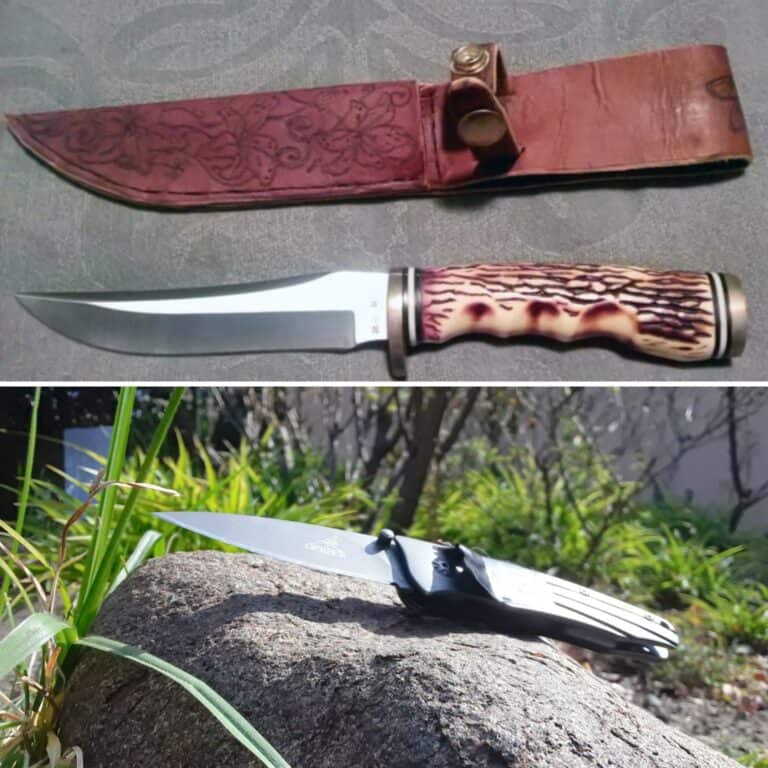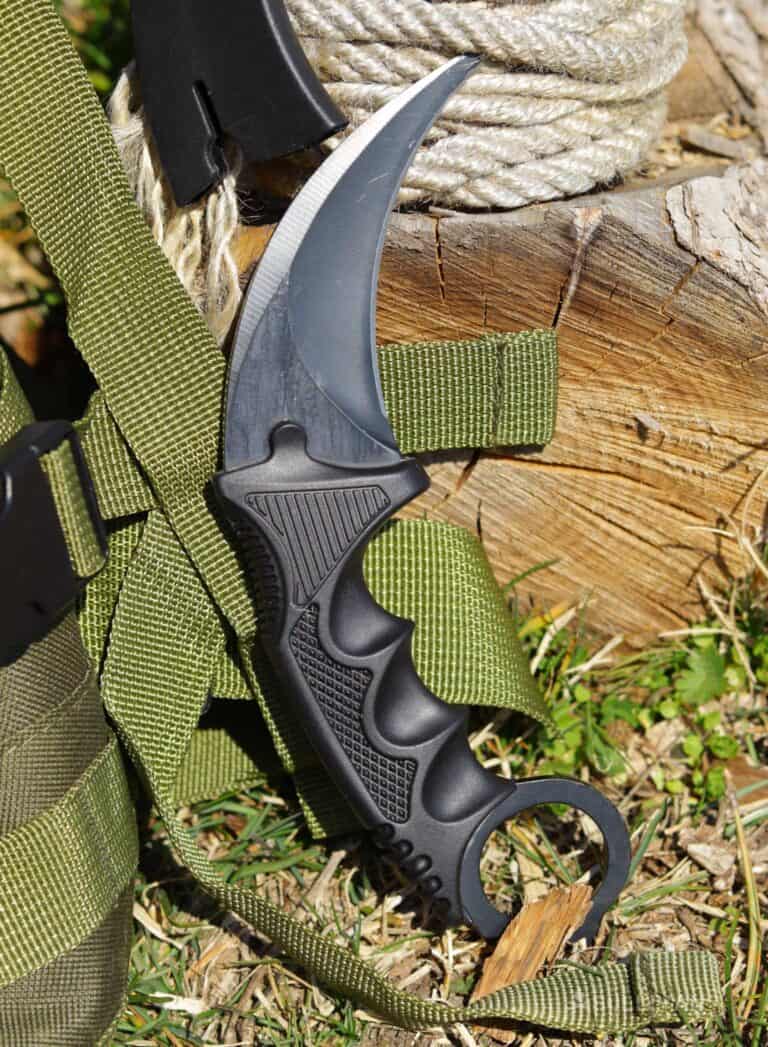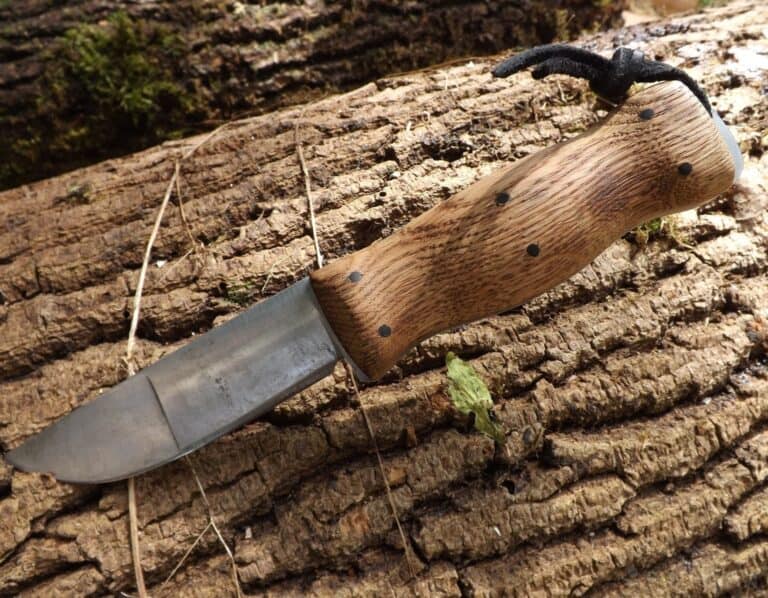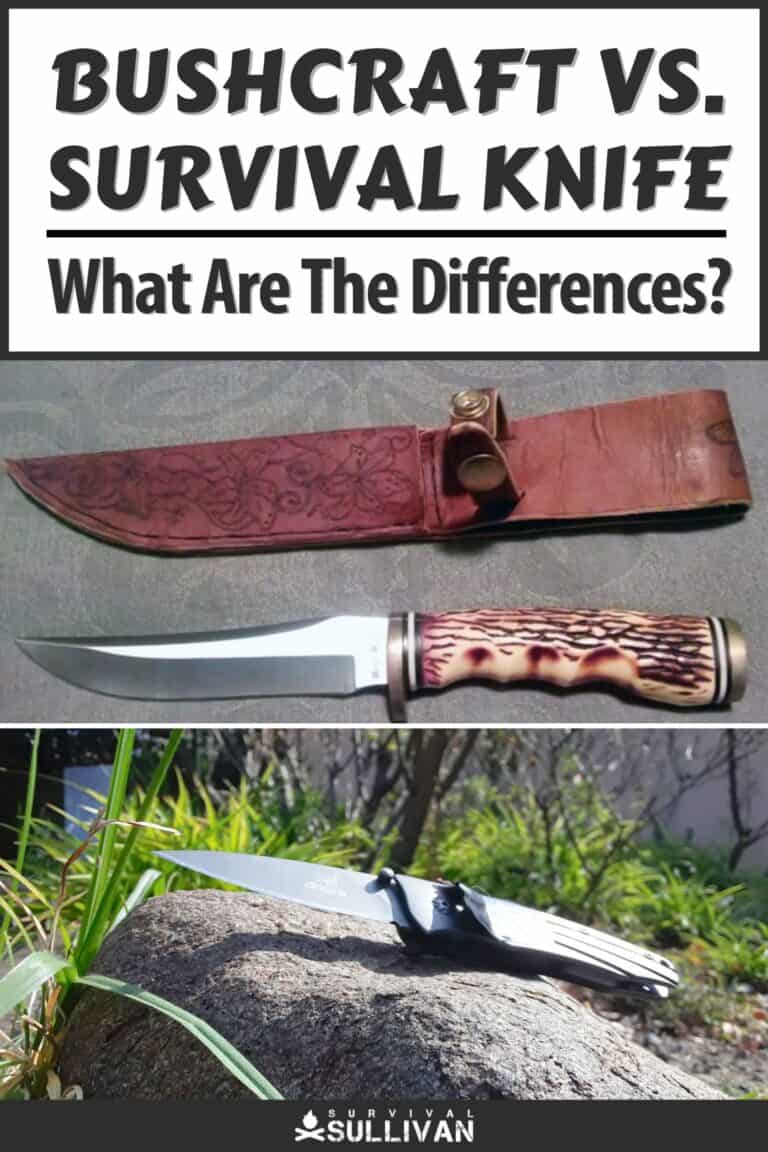If you’re an outdoor enthusiast or someone looking to learn about survival then you’ve probably gone shopping for a knife at some point.
One of the problems you’ll come across is understanding which blade is good for which tasks. You don’t want to destroy your survival knife’s blade doing something you weren’t supposed to with it…

Bushcraft and survival knives are two types of blades that are commonly mistaken for each other.
They’re often used interchangeably, and this can confuse newcomers. In your search for a new knife, you may find yourself asking what sets each knife apart from the other…
The main differences between them are blade length and design. Shorter bushcraft blades are up to 5 inches long, excelling at chores like skinning game. A survival knife is between 6-12 inches, great for heavier tasks such as batoning wood.
The overarching theme of survival knives has been around for more than 40 years and their unique differences are subtle.
Before going out and buying what you think might be effective, let’s take a look at the reasons you would want a bushcraft or survival knife.
A Quick Comparison Table
While both types of knives have their advantages and disadvantages, the differences between them are distinct.
Here is a handy chart that gives you an overview of how different these two knives are.
| Feature | Bushcraft Knife | Survival Knife |
|---|
| Size | Smaller | Larger |
| Blade Length | 3-5 inches | 6-12 inches |
| Blade Type | Fixed, Full-Tang | Fixed, Full / Partial Tang |
| Blade Material | Stainless Steel / Carbon Steel | Stainless Steel / Carbon Steel |
| Blade Shape | Scandinavian grind | Single edge / Semi-Serrated |
| Handle Material | Wood, plastic, rubber | Wood, plastic, rubber |
Bushcraft Knives
Bushcraft is the intention of living in nature using minimal gear and the resources around you.
If you need something to feel comfortable then you will often build it yourself. Practically speaking, you will more than likely not be in a survival situation.
A bushcraft knife has a smaller blade and is used for more delicate tasks. That doesn’t mean that it sacrifices any strength as the steel used in both types of knives is comparable.
Blade Dimensions
To be considered a bushcraft knife the blade will have to be between 3-5 inches in length and ⅛ to 1/16th of an inch thick.
The blade needs to provide strength and the ability to make nimble cuts, such as those needed to dress wild game or set up a trap.
Blade Type
Don’t let knockoff blades fool you, a high-quality bushcraft knife will be full tang with no moving parts.
If you see a website offering foldable bushcraft knives then it’s best to look elsewhere. Foldable knives don’t offer the same stability as fixed blades and can break with heavy use.
A full tang is another way of saying the blade runs through the handle. It provides a way for energy to be dispersed evenly, giving strength to the blade for tougher jobs.
If you were to take the handle apart you will see the blade taper into a spike that is wedged within the handle.
Blade Shape
The grind refers to how the cutting edge of the blade is shaped. It is what determines the sharpness of the blade and how well it maintains that edge.
Bushcrafters will often choose a scandi (Scandinavian) or convex grind as they are easier to use for woodworking.
They are also incredibly easy to sharpen and maintain over a long period of time.
Blade Handle
The blade handle is the most customizable part of the knife and is often the result of personal preference.
However, the main factor is that the handle material should be rugged for longevity. Classic bushcraft knife handles are often made of wood with modern models using hard plastic or durable rubber.
With any knife you’ll want to try out the handle for comfort before purchasing since you’ll be using it for many years.
Why Would You Use One?
One of the staples of bushcraft is working with wood to create tools to make your time outside easier.
For example, creating a pot hanger out of wood is a great way to boil water over a fire. As you are carving the notches for the “crane” part of the hanger you’ll notice that a smaller blade makes it easier to carve into the wood.
Skinning an animal is a delicate task since you have to fit the knife between the skin and the meat. The thinner blade found on a bushcraft knife makes it easier to separate the two layers.
Additionally, since the blade is so small, you can avoid cutting too far and causing a tear.
Here is a quick list of tasks that a bushcraft knife is commonly used for:
- Throwing sparks from a Ferro rod to start a fire
- Constructing a shelter
- Batoning wood with the aid of a stick or mallet
- Shaving feather sticks
- Cleaning, skinning, and butchering animals
- Intricate wood carving (whittling)
The smaller blade is obviously not suited for bushwhacking and other large tasks. Instead, it is best suited for camp chores and general usage.
Survival Knives
The best survival knives are stout and able to handle some of the most grueling of survival tasks including chopping, batoning, digging, and defending.
The idea is that this kind of knife can handle many aspects of surviving without breaking or losing its edge.
Unlike bushcraft knives, the survival category has a few sub-types of knives that are included.
Common examples are the kukri and the tanto knives which are mildly effective at cutting, sawing, and splitting but do not excel at any of them.
You’ll notice that survival knives and tactical knives will often share blade shapes and are often labeled as the same type of knife.
Blade Dimensions
A high-quality survival knife will have a blade that is between 6-12 inches in length with the preference being up to you.
If you’re looking to split large branches then you’ll want to stick to the longer length.
The blade thickness shouldn’t be any less than ⅛ of an inch with ¼ of an inch being ideal as it will absorb more impact.
Blade Type
With any kind of survival knife you’ll want to go with a full tang. It provides the strength needed to get through tougher materials.
The issue with folding survival knives is that they lack the strength to be used for heavier tasks repeatedly without breaking.
Much like a bushcraft knife, it should have a fixed blade to avoid breaking. Survival knives have a serrated edge, great for sawing through wood and metal or a straight blade making them excellent for cutting.
There are hybrid knives that are half straight and half serrated for added versatility.

a karambit knife
Blade Shape
Survival knives come in several different shapes with some being better suited for wilderness survival.
For example, a double-edged spear point blade has two sharpened blades, on the top and bottom. This is better for combat than wilderness survival as there is no spine on the knife.
A knife like the tanto does not have a curved belly which hinders their ability to skin wild game. These knives are also better suited for close quarters combat as opposed to survival.
A clip point knife, like that found on a bowie, has a large curve at the tip that tapers at the end.
Clip points make for excellent survival knives as long as they aren;t too curvy. This is because they can easily break if you push the tip into something hard.
The curve actually makes the knife excel at skinning game as more of the blade makes contact with the animal.
The last shape is a drop point tip and is commonly the best type of blade shape to get. It has a straight, flat spine making it great for batoning wood.
It has a very sharp tip that is great for stabbing and protection. It also has a slight belly which is great for skinning wild game.

A beautiful hand made knife by Texas based custom knife maker William Collins, It features a part hollow and part blended sabre grind, is made of O1 tool steel with a red oak handle and micarta pins.
Blade Handle
Depending on the survival knife, the handle will be secured to the blade as a single piece or connected on either side of the metal part with a fastener.
Just like a bushcraft knife wood, rubber, and plastic can be used. Higher end knives will use a material called Micarta, a composite made with inorganic, microporous materials that are compressed and sealed in resin.
Why Would You Use One?
In a survival situation, every little bit of help matters, and a knife is a key item to have. Survival knives are meant to handle an abundance of tasks including:
- Batoning wood
- Skinning prey
- Opening cans
- Digging
- Defense
- Bushwhacking
There are many more uses beyond what’s listed here which is why a survival knife is one of the best items to have on you.
For a more in-depth look into what you can use a survival knife for, check out this video:
[TAG3]
Handle Ergonomics
How the blade feels in your hand plays an important role in the functionality of either type of knife.
A bushcraft knife needs to be comfortable in your hand as you will be holding it for long periods at a time.
This is because you will be using the knife to help build your equipment and a handle that is rough on the hands will cause discomfort and damage.
Survival knives have larger blades and more potential to injure yourself. Since you will be using it in labor intensive scenarios you want a handle that has a strong grip so your hand doesn’t accidentally slip and you get cut.
Which Knife Should You Choose?
Whatever knife you choose mostly comes down to personal preference. This is largely due to both types of knives sharing the qualities of the other.
Bushcrafters may prefer a thick blade, like that found on a survival knife where others prefer the grind of a bushcraft knife for their survival blade.
The best advice is to try both types of knives and figure out which one works best for what you want to accomplish in the wild.

The post Bushcraft Vs. Survival Knife – What Are The Differences? appeared first on Survival Sullivan.
By: Perrin Adams
Title: Bushcraft Vs. Survival Knife – What Are The Differences?
Sourced From: www.survivalsullivan.com/bushcraft-vs-survival-knife/
Published Date: Tue, 04 Jul 2023 16:00:00 +0000
------------------------
Did you miss our previous article...
https://bushcrafttips.com/bushcraft-news/run-to-the-hills-what-to-consider-before-moving-to-the-country
 What is BushcraftSurvival SkillsToolsVideosBushcraft CampsBushcraft KitsBushcraft ProjectsPrivacy PolicyTerms And Conditions
What is BushcraftSurvival SkillsToolsVideosBushcraft CampsBushcraft KitsBushcraft ProjectsPrivacy PolicyTerms And Conditions
